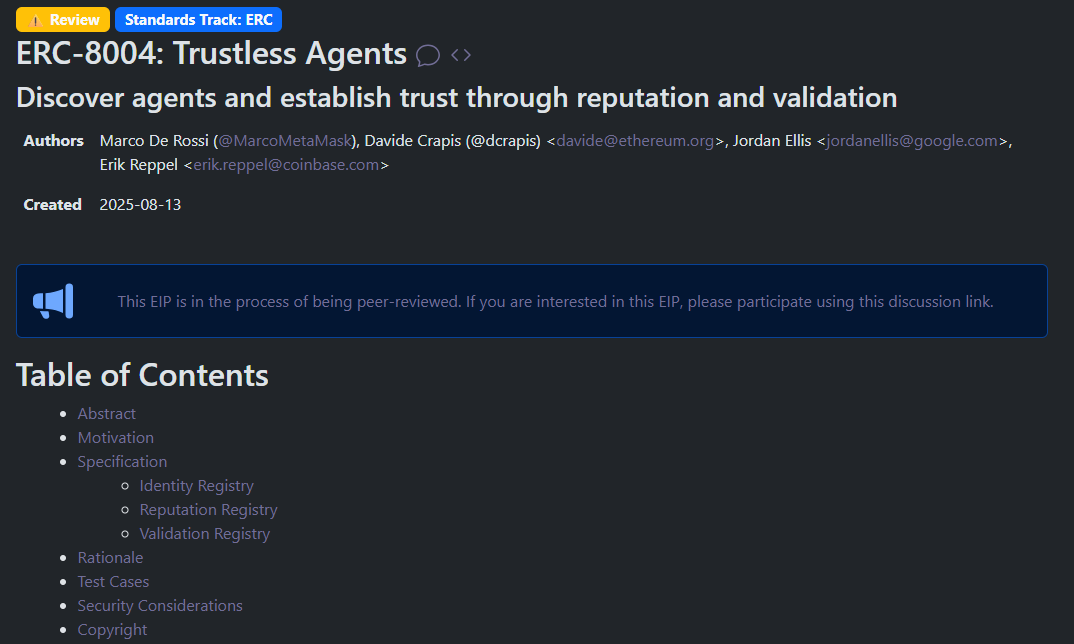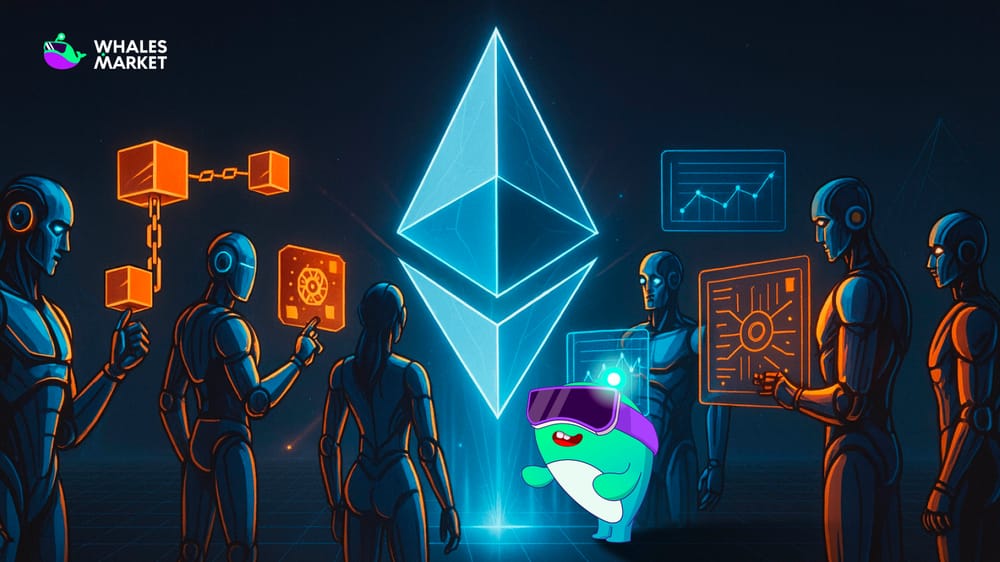Imagine a world where AI agents can automatically hire each other to get jobs done, build reputation like humans, and transact without relying on third parties. Sounds like science fiction? That is exactly what ERC-8004 is working to make real today. But is it truly a game changer? Let’s find out.
What is ERC-8004?
ERC-8004 is a new Ethereum standard designed to build a system of Trustless Agents, where AI agents can collaborate and transact transparently without needing mutual trust.
It takes inspiration from Google’s A2A (Agent-to-Agent) protocol but adds blockchain on top, making the data public and removing intermediaries. Unlike ERC-20 (tokens) or ERC-721 (NFTs), this standard focuses on on-chain identity for AI. It was first proposed in August 2025 as EIP-8004, paving the way for a decentralized AI economy.

How does ERC-8004 work?
ERC-8004 revolves around three core registries:
- Identity Registry: Every AI is assigned an NFT, similar to an ID card. The NFT includes a profile describing what the AI can do.
- Reputation Registry: After completing tasks, clients leave feedback. Reviews are tied to payment records, making it difficult to fake or manipulate.
- Validation Registry: For sensitive tasks, an AI can request third-party validation using technologies like TEE or zkML. Think of it as having an expert sign off that “this AI did the job correctly.”
Example in practice: A user hires an AI to analyze an investment portfolio and pays $100 in x402. ERC-8004 allows verification of whether the AI has a legitimate identity, a history of good work, and even third-party validation of the report quality. Once approved, payment is released automatically and the review is stored on-chain, fully transparent and tamper-proof.
What are the key technical advantages of ERC-8004?
- Trustless interaction: Agents can collaborate without intermediaries, using cryptographic proofs for verification.
- On-chain permanence: Identities and reputations are permanently recorded on Ethereum, building long-term trust.
- Seamless integration: Built on familiar ERC standards like ERC-721, making it easier for developers to plug into DeFi, DAOs, or NFT platforms.
- Scalability for the AI economy: Provides the infrastructure for a market of AI agents potentially worth tens of billions of dollars.
Why is ERC-8004 needed?
AI is expanding rapidly, but most systems today rely on centralized platforms like Google or AWS, which can be controlled or manipulated. ERC-8004 brings AI to the blockchain, solving trust issues by verifying identity and reputation directly on-chain. This reduces risks of fraud or reliance on middlemen.
With AI projected to reach trillions in market value, Ethereum needs a unified standard to attract agents. Without ERC-8004, the ecosystem risks becoming fragmented and unsafe.
Consider a scenario: a user hires an AI for portfolio management, writing, or data analysis, and pays with x402. The questions are:
- How can the AI’s credibility be trusted?
- How can the results be verified as accurate?
ERC-8004 addresses this by:
- Issuing a verifiable identity that cannot be faked.
- Recording history and reviews publicly, without edits.
- Allowing third-party validation, like a certificate of authenticity.
As @MTorygreen put it: “Reputation is collateral for AI.” Agents with transparent track records will outcompete others.
Agent reputation is now real collateral.
— Tory | io.net 🦾 (@MTorygreen) October 27, 2025
What happens when models hallucinate while controlling millions of USD?
Vibes stop mattering, and receipts start to matter a whole lot.
Two ledgers decide which agents survive:
1. Cash ledger (spend, earn, slippage, VaR). Did it handle…
Potential and challenges
Potential
Practical use cases
- DeFi: Agents can manage portfolios, run arbitrage, or execute strategies with on-chain reputations.
- Gaming: NPCs can hire agents for in-game services, creating dynamic in-game economies.
- Code review: AI agents can audit code and get paid based on quality.
- Research agents: Specialized in analyzing DeFi or broader market trends.
- DAO operations: Automating tasks inside decentralized organizations.
Adoption is already moving: Layer 2 networks like Taiko and Base are officially supporting ERC-8004 as core infrastructure for the agent economy. Projects like Questflow, Oasis Network, and ChaosChain have started building on top of it.
We're backing ERC-8004 from the @ethereumfndn's dAI team.
— Taiko.eth 🥁 (@taikoxyz) October 23, 2025
ERC-8004 is a novel protocol for trustless agents to discover each other, build a reputation, and transact without gatekeepers. We're deploying contracts on Taiko and supporting developers who build autonomous…
Network effect: Just as ERC-20 enabled the token economy and ERC-721 built the NFT market, ERC-8004 could lead to an agent society – a decentralized network of agents with self-organized trust.
Challenges
- Multi-layer security: The minimal design shifts responsibility to implementations, exposing risks like:
- MEV-style attacks on domain registration
- Feedback manipulation via weak authorization
- Storage overload from unlimited validation requests
- Sybil attacks creating fake reputations
- Developer tooling: Setting up Identity, Reputation, and Validation registries is still complex. More user-friendly tools are needed.
- Scalability issues: Millions of agents transacting nonstop will require low gas fees and high throughput. Gas sponsorship (EIP-7702) could help but needs wide adoption.
- Centralized competition: Companies like Google and Microsoft are building agent ecosystems with strong UX. ERC-8004 must prove decentralization offers greater value.
- Incomplete standardization: ERC-8004 remains in draft form, moving toward v2 spec. Broad community consensus and extensive testing are still required.
- Reputation bootstrap: New agents without history need fair ways to start, possibly via staking or delegated reputation.
- Privacy vs transparency: Agents must balance confidentiality (e.g., trading strategies) with transparency for credibility. TEE and zk proofs can help, though they add complexity.
- Market risks: The narrative is still early. Many related projects have small market caps, low liquidity, and high volatility. Investors must be cautious.
Conclusion
Looking toward 2026, ERC-8004 is expected to integrate tightly with Layer 2s to cut fees, connect with leading AI initiatives like OpenAI, and expand into multichain systems. Ethereum could evolve into the main hub for decentralized AI, combining the strengths of crypto and artificial intelligence.
FAQs
Q1: Is ERC-8004 a new token?
ERC-8004 is not a token. It defines infrastructure for identity (via NFTs), reputation, and validation. It supports the agent economy but is not itself a tradable asset.
Q2: How much gas does an agent need to register?
Costs vary depending on the Layer 2 used. On Base or Optimism it is usually under $1. With EIP-7702 gas sponsorship, clients may not need to pay gas at all.
Q3: Who decides which agents are trustworthy?
There is no central authority. Each client decides based on reputation scores, validation proofs, and review history. Competing reputation markets may emerge.
Q4: Can ERC-8004 work cross-chain?
Yes. With CAIP-10, an agent ID can function across multiple chains. An agent registered on Ethereum mainnet can also interact on Arbitrum, Base, or other L2s.
Q5: Where can developers start building on ERC-8004?
Developers can check the official EIP-8004, explore the reference implementation on GitHub, and join builder programs announced on the Ethereum Magicians forum.

